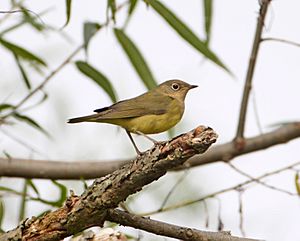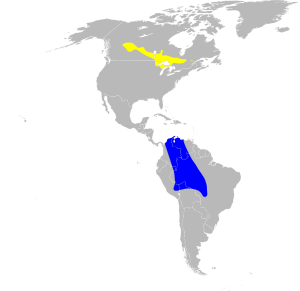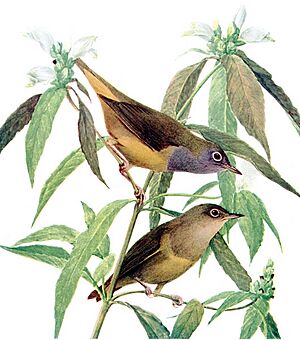Connecticut warbler facts for kids
Quick facts for kids Connecticut warbler |
|
|---|---|
 |
|
| Conservation status | |
| Scientific classification | |
| Genus: |
Oporornis
|
| Species: |
agilis
|
 |
|
| Range of O. agilis Breeding range Winter range | |
The Connecticut warbler (Oporornis agilis) is a small songbird that belongs to the New World warbler family. It's known for being a bit shy and hard to spot. Even though it's called the Connecticut warbler, it doesn't visit Connecticut very often! This bird travels very long distances between its summer homes in Canada and the northern U.S. and its winter homes in South America.
Contents
About the Connecticut Warbler
These medium-sized warblers are about 13–15 cm (5.1–5.9 in) long. That's about the length of a small ruler. Their wings can spread out to about 22–23 cm (8.7–9.1 in) wide. Young warblers weigh about 10 g (0.35 oz). Adult birds usually weigh around 15 g (0.53 oz). However, before they migrate, they eat a lot to gain weight. They can weigh up to 25 g (0.88 oz) to prepare for their long journey.
Connecticut warblers have light yellow feathers on their bellies. Their backs are olive green. They have a light ring around their eyes and pink legs. Their tails are long, and their wings have pale bars. They also have a thin, pointed beak. Male warblers have a grey "hood" on their heads. Females and younger birds look more brown and have a whitish throat.
These birds usually look for food on the ground. They pick through dead leaves or hop along branches. Like most warblers, they mainly eat insects and other small creatures. This includes spiders, snails, and caterpillars. Sometimes, they also eat seeds and berries. They are "skulking" birds, which means they like to stay hidden. They spend most of their time looking for food in thick, low plants. This makes them quite hard to see!
Where They Live
Connecticut warblers spend their summers in bogs or open deciduous forests near water. They especially like areas with poplar, spruce, tamarack, or aspen trees. These areas are mostly in central Canada and the states near the Great Lakes. These places are often far away and hard for scientists to reach. Because of this, there isn't a lot of information about these birds.
Family Life
Connecticut warblers start looking for mates when they arrive at their summer homes. This is when the males begin to sing to attract females. Each pair usually raises one group of babies per year. They like to build their nests in thick plants close to the ground. This helps keep their young safe from predators. Most eggs are laid in mid-June, but some are laid in July.
Their eggs are a creamy color with chestnut and bay spots. Only the female bird sits on the eggs to keep them warm. The baby birds usually leave the nest in late July or by the end of August. Both parents work together to feed their young. They bring them caterpillars, larvae, moths, and berries.
What They Sound Like
The song of the Connecticut warbler is loud and repeats "cheepa-cheepa." It sounds similar to the Kentucky warbler and the Ovenbird. Their call is a nasal "pitch" that sounds like a raspy "witch." Like many songbirds, you hear their song mostly during the breeding season. They rarely sing in the fall.
How They Behave
The Connecticut warbler walks on the ground to find insects and other food. Its tail bobs up and down as it walks. This movement is similar to how wrens and sandpipers move. Connecticut warblers are usually solitary birds. This means they like to be alone. However, groups of about twenty-five birds will gather in the fall before they migrate. They also sometimes join other bird species, like Blackpoll warblers, to feed in the fall.
During the breeding season, male warblers are very protective of their space. They defend an area that is about 0.24 to 0.48 hectares big. Both parents help feed their young. They also protect their babies by screeching loudly at predators.
Their Amazing Journey
As mentioned, the Connecticut warbler is a bit mysterious. We don't know much about them outside of the breeding season. This is because fewer than 25,000 individual birds have been tagged with bands. These birds migrate all the way to the Amazon Basin in South America for the winter. They have been seen in Colombia, Venezuela, Guyana, and Peru.
Connecticut warblers take different routes when they fly south in the fall compared to when they fly north in the spring. This is quite unusual! In spring, they usually fly through the Midwest. They rarely go to the East Coast. But in the fall, many more birds fly along the East Coast.
Recently, scientists have used small tracking devices to learn more about their migration. They found that some birds fly over open water, just like the Blackpoll warbler. They even recorded a two-day flight over the Caribbean to the Antillean islands. This matches sightings of Connecticut warblers in Bermuda, St Thomas, and St Martin. The island of Hispaniola is also a common stop. This long flight over open water requires a lot of energy. This is why fat Connecticut warblers can be found on the East Coast in early fall. It's also why they make several stops on their way south.
Dangers They Face
One of the biggest dangers for Connecticut warblers during migration is flying into man-made buildings. They often hit clear glass windows because they can see plants and light through them. Losing their habitat is another big threat to these birds. Cutting down Aspen trees where they breed, like in BC, and using pesticides destroys their nesting spots. An insect called the budworm can also harm jack-pine trees, which are nesting sites.
Power lines are also dangerous for Connecticut warblers. Studies show that fewer warblers live in areas with power lines. In Alberta, noise from gas pipelines also harms the species. Studies show that Connecticut warblers do well in forests where shrubs have been cleared, as they prefer trees. However, their numbers drop in areas where the forest has been completely cut down.
The Connecticut warbler is listed as a species of "Least Concern" by the IUCN. This means they are not currently in great danger of disappearing. However, some groups of these birds in Saskatchewan, Michigan, Minnesota, and Wisconsin are at risk. It's hard to help them because there isn't much research. Still, some researchers have made plans to protect their favorite woody wetlands.
See also
 In Spanish: Reinita de Connecticut para niños
In Spanish: Reinita de Connecticut para niños



